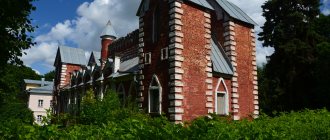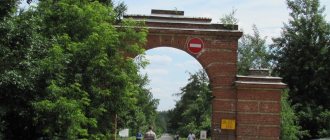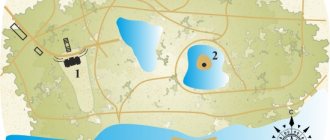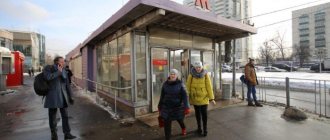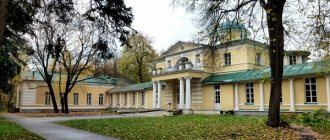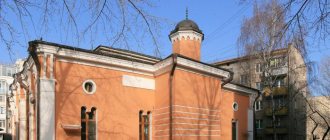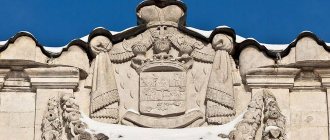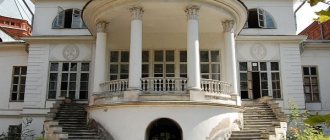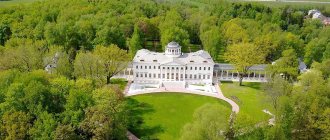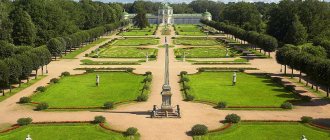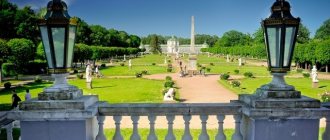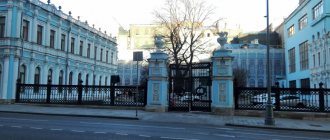The estate of the princes Golitsyn in the Moscow district of Kuzminki
The history of the estate dates back to the times of Peter the Great. In 1702 it was an estate with a mill, which A.G. brought as a gift to his favorite. Stroganov Peter I. So he thanked the count for helping to equip the army and navy. On the land allocated by Peter I, a temple was built in 1716. It was consecrated in honor of the Blachernae Mother of God and the nearest village, Blachernae, was named after her.
His father’s work was continued by his heir, son Alexander, thanks to whom several ponds appeared on the territory. Stroganov's daughter, Anna Alexandrovna, became the wife of Prince M.M. in 1757. Golitsyn, and the estate was given to her as a dowry. The prince's family owned Kuzminki until 1917.
During this time, the estate turned into a landscaped and expanded country estate, built to European standards. In order for it to reach such a high level, famous architects, artists, and sculptors worked on its improvement. After the revolution, the estate was nationalized and transferred to the Institute of Experimental Veterinary Medicine.
Since 1995, some objects of the estate were subject to restoration:
- temple;
- round pier;
- outbuildings located around the main manor house.
The Golitsyn estate in Kuzminki is famous for the fact that famous cultural figures of that time showed their skills here: Russian and Swiss architects S. Chevakinsky, R. Kazakov, P. Klodt, the Bykovsky dynasty of architects and artists. Thanks to the grandeur of the architectural ensembles, beautiful location, and exquisite interior furnishings, this place was called the Russian Versailles.
Since 1999, it has been the Museum of Russian Estate Culture, where various excursions, theme evenings, folk and classical music concerts are held, and hobby classes are organized. Those who want to get involved in the history of Russian culture can visit the estate and enjoy its beauty and grandeur.
The full cost of the ticket is 300 rubles, visitors belonging to the preferential category pay 150 rubles.
Estate of Princes Golitsyn, main house Architect: S.I. Chevakinsky in 1759; in 1929 it was added two floors, as a result of which it lost the pediment Reconstruction and adaptation: 2017–2021 Central scientific and restoration design workshops Concept and interiors: AgitArkh studio Total area: 6,584 sq. m Exhibition area: 3,025 sq. m
Over the three centuries of its history, the estate of the princes Golitsyn on Volkhonka has repeatedly changed its appearance. The author of the original project was the famous St. Petersburg architect Savva Chevakinsky. In 1774, the estate was rebuilt and became the central part of the Prechistensky Palace, built according to the design of Matvey Kazakov for Catherine II.
The walls of this house have seen many famous people. A.S. appeared at luxurious balls more than once. Pushkin. Alexander Sergeevich was even going to get married to Natalya Goncharova in the house church of Prince Golitsyn, but the wedding ceremony was arranged in the Church of the Ascension of the Lord at the Nikitsky Gate. In 1877, Alexander Nikolaevich Ostrovsky settled in the main house. Here he completed the play “The Last Victim”, wrote “Dowry”, “Heart is not a Stone”, “Talents and Admirers”. In 1885, the neighboring apartment was occupied by Ivan Sergeevich Aksakov, one of the leaders of the Slavophile movement. In 1865, a free museum consisting of family collections was opened in five halls of the main house of the Golitsyn estate. The museum had three sections: Western European painting, sculpture and decorative arts; ancient monuments; library. The picturesque collection of the owners of the house included works by Bruegel, van Dyck, Veronese, Canaletto, Caravaggio, Perugino, Poussin, and Rembrandt. A year later, due to financial difficulties, the museum’s collection was sold to the Hermitage.
After the revolution, in the late 1920s, the main house of the estate became the Communist Academy; it was built on two floors, as a result of which the pediment was lost. The impressive gate, crowned with the princely coat of arms of the Golitsyns, is the only thing that has survived to this day in its original form.
After the reconstruction is completed, the Gallery of Impressionist and Post-Impressionist Art will open in the former building of the central building of the Golitsyn estate, which will exhibit works by outstanding masters of the second half of the 19th - early 20th centuries: Manet, Monet, Renoir, Degas, Pissarro, Cezanne, Gauguin, van Gogh, Matisse and Fauvists, Picasso and Cubists, originating from the collections of the famous pre-revolutionary Moscow collectors S.I. Shchukin and I.A. Morozova.
History of the estate
Over the years of its existence, the estate has changed, as have its owners and name. The mill, Kuzminki, the village of Vlahernskoye - every stage of the development of the estate is a bright page in the history of our country.
Under the Stroganovs
Since Peter I donated land with a forest, a pond and a mill to Count Stroganov, the history of the estate began. The count began construction with a manor house and several buildings for household needs. In 1720, a wooden church was erected here, where the miraculous image of the Blachernae Icon of the Mother of God, donated to Count Stroganov, was brought, which became a family treasure forever.
During these same years, the Stroganov family built a large pond. Now it is called Verkhniy Kuzminsky.
Under the Golitsyns
The Golitsyn period of development of the estate began with the wedding of the eldest daughter of Count Stroganov and Prince M. Golitsyn (1757) and lasted until the revolution of 1917.
This time was marked by the following changes:
- A cascade of ponds was built.
- The area of the land increased due to the acquisition of neighboring properties.
- The manor house, horse yard and some other buildings were being reconstructed.
- The entrance gate became the decoration of Linden Alley.
- Dachas have been built.
The Golitsyn estate in Kuzminki received many guests, among whom were representatives of the royal family: Empress Maria Feodorovna and the emperor and his sons. A monument erected to him became a memorable sign in honor of the visit of Emperor Nicholas I.
The year 1912 for this area was marked by the transition of the territory to a new owner - the city authorities. In 1916, the manor house burned down, the fire took away many paintings, mahogany furniture, and a collection of engravings.
During Soviet times
The nationalization of 1917 did not bypass this estate: its next owner, until 2001, was the Institute of Experimental Veterinary Medicine, located on the site of the burnt manor house.
After the revolution, the estate was not properly maintained. The buildings were repurposed and became laboratories and administrative offices.
Park cast-iron furniture, gates, and monuments were turned into scrap metal. The church suffered a similar fate: it was closed and rebuilt. The wooden buildings located on the territory burned down. Part of the once beautiful park was cut down.
Bolshie Vyazemy – Golitsyn estate
From the end of the 17th century until 1917, the Bolshie Vyazemy estate belonged to the Moscow branch of the family of princes Golitsyn. The four owners of Big Elms are noteworthy: the educator and faithful comrade-in-arms of Peter I Boris Alekseevich Golitsyn, the builder of the preserved manor house and outbuildings Nikolai Mikhailovich Golitsyn, the hero of the war of 1812 Boris Vladimirovich, nicknamed Vestris, and his brother, Moscow governor-general Dmitry Vladimirovich Golitsyn.
In 1694, Vyazemy was granted to the tutor of Tsar Peter I, Boris Alekseevich Golitsyn, for supporting the young sovereign during the Streltsy revolt. The decree spoke of a grant to “the boyar Prince Boris Alekseevich Golitsyn from the palace villages, the village of Nikolskoye Vyazem with villages and from the peasants...” The royal grant took place on March 25 on the day of the Annunciation, two weeks after the death of Boris Alekseevich Golitsyn’s father, who had Khilkovskaya from his mother patrimony - the village of Troitskoye-Podosinki not far from Vyazem.
Although the main estate of the Tsar’s “uncle” Boris Alekseevich near Moscow was the village of Dubrovitsy not far from Podolsk, Golitsyn also visited Vyazemy, and construction work was carried out on the estate. In Ambassador Korb's diary there is a brief mention of the “village of Vyazemka,” which at that time belonged to Prince Boris Alekseevich Golitsyn. I am following the Smolensky tract; due to the dangers from “potholes and many intermediate bridges,” the embassy stopped in the forest for the night near Vyazem. Korb praised the beauty of the church, which Prince B.A. Golitsyn allegedly built it at his own expense, hiring Italian masons. The ambassador was mistaken: the church was built long before Golitsyn at the expense of Boris Godunov. Perhaps we were talking about repairs and minor reconstructions that were actually carried out in the church during the time of B.A. Golitsyn. In addition, Boris Alekseevich ordered the reconsecration of this ancient temple, after which it began to be called not Trinity, but Preobrazhensky in memory of the royal village of Preobrazhenskoye, where young Peter took refuge during the Streltsy riot.
Boris Alekseevich Golitsyn had many other land holdings, in addition to the “honored patrimony” of Nikolsky Vyazema. They were located in Novosilsky, Kaluga, Tarussky, Suzdal, Ryazan and other districts. Boris Alekseevich Golitsyn himself, shortly before his death, took monastic vows in the Florishcheva Hermitage in the Vladimir province with the name Bogolep. By the way, its namesake and former owner of Vyazem, Tsar Boris Godunov, took the same name as a monk before his death.
According to his father’s will, Vasily Borisovich Golitsyn was supposed to become the second owner of Vyaz, but a tragic accident prevented this. The young prince (he was twenty-nine years old) died during a gala dinner in the Moscow chambers of Yakov Massalsky in 1710: the ceiling unexpectedly collapsed on the guests.
Since 1766, Vyazemy passed to Prince Nikolai Mikhailovich Golitsyn. He settled in Vyazemy, where he took up farming and large-scale construction “with great love for his village.” It was under Nikolai Mikhailovich, the great-grandson of the Tsar’s “uncle” B.A. Golitsyn, the preserved stone manor house and outbuildings of the estate were built. Construction took eighteen years from 1766 to 1784.
In 1803, the Vyazema estate was transferred to Boris Vladimirovich Golitsyn, a poet and hero of the Patriotic War of 1812. He was excellent at the art of dancing, for which in his youth he received the nickname Vestris, after the famous dancer of that time. Boris-Vestris and his brother Dmitry spent their childhood and youth in Europe. The prince showed himself early as a writer: in 1788, the works of Boris Vladimirovich in French were published in the French press, in particular, his story “Aurora” was published in the “Literary Almanac”. A year later, the calm life of the Golitsyn brothers abroad was disrupted by the French Revolution. Boris-Vestris’s brother Dmitry, still almost a boy in 1789, was in Paris during the bloody events of the uprising and passed through Place Bastille “at the very moments when the Parisian mob attacked the fortress,” wrote P. Sheremetev. D.V. Golitsyn even took an indirect part in this assault and moved some things from one place to another. During street fighting, the house where the Golitsyns lived in Paris was occupied by royal troops, essentially turning it into a fortress for a while. However, at this time, Boris-Vestris, according to Pavel Sheremetev, “was completely absorbed in the interests of French literature, becoming a French poet whose works were published along with various celebrities.” While in revolutionary Paris, Boris Vladimirovich Golitsyn did not delve deeply into what was happening: at the height of the rebellion, he wrote poems about lilacs.
Frightened by the uprising in France, Tsarina Catherine II hastily ordered the brothers Boris and Dmitry Golitsyn to leave Paris for Russia in 1790. The brothers traveled for many months, along the way, or rather, deviating from the direct path to their homeland, they visited the cities of Italy. Finally, the Golitsyns arrived in Moscow, where many greeted them with caution, suspecting that the young people who witnessed the beginning of the events of 1789 were themselves secretly almost revolutionaries. However, these were only rumors: Boris and Dmitry Vladimirovich were loyal to the throne and both chose military service. Prince Boris-Vestris quickly moved along the military line, and at the age of 30 he already became a lieutenant general. “It was an amazing combination: lyrical poetry, guitar, first-class dancing skills and strict discipline,” wrote P. Sheremetev. In 1800, an absurd incident occurred in Riga, due to which Boris Vladimirovich was removed from military command for several years. One day his regiment was walking down the street and beat the drums at the moment when the wife of the German consul was giving birth in a neighboring house. The birth was unhappy. The baby died, it was believed, from fright caused by the drumming of Prince Boris's regiment.
For some time, removed from military service, Boris-Vestris enjoyed a free life in Moscow, but in 1802 he was summoned by the new Emperor Alexander I to return to military affairs. In 1803, Boris Vladimirovich was sent for service to Smolensk, and just at that time he inherited the village of Vyazemy near Moscow from his cousin. In 1805, Boris-Vestris was seriously wounded in the battle of Austerlitz and retired for a time. In 1812, with the beginning of the Patriotic War, Boris Vladimirovich returned to the active army. He was again seriously wounded in the Battle of Borodino, but remained in service. Boris Golitsyn was unable to recover from his wound - he died on his birthday in 1813 in the city of Vilna, and the ashes of the hero were transported to the tomb of the Transfiguration Church of the Great Elms. Boris-Vestris is survived by two illegitimate daughters, whom a gypsy gave birth to.
After the death of Prince Boris Vladimirovich, Vyazema’s estate was inherited by his brother Dmitry Vladimirovich Golitsyn. He, being a military man, also participated in many battles of the War of 1812, although he went down in history as the permanent head of Moscow for twenty-four years from 1820 to 1844. In 1820, the old capital was still post-fire, destroyed by war. Under Dmitry Vladimirovich Golitsyn, famous monuments to the Patriotic War were founded in Moscow: the Alexander Garden, the Triumphal Arch, the first Cathedral of Christ the Savior. A bust was erected to Dmitry Vladimirovich Golitsyn himself in the park of the estate in Bolshiye Vyazemy with the inscription on the pedestal: “His Serene Highness Prince Dmitry Vladimirovich Golitsyn, hero of the Patriotic War of 1812, owner of the Vyazemy estate, Moscow Governor General.”
Objects of the Golitsyn estate
Since 1997, the attention of the authorities was drawn to this historically valuable site, and it became the Kuzminki-Lublino natural, historical and cultural complex. The music pavilion was restored, a museum was opened, and exhibitions were prepared.
Building on the site of the manor's courtyard
The main building of the site was a residential wooden house in which the owners of the estate lived. Since 1916, it housed a military hospital, which subsequently burned down. In its place in the 30s of the twentieth century, a new building was erected, which now attracts the attention of visitors.
The outbuildings, once located on both sides of the main building, have been restored. They house exhibitions that tell guests about the history of the development of the estate.
Egyptian pavilion
This building is located in the Red Court; it was previously used as a kitchen, connected to the owner’s house by a gallery. Products were stored in basements, and the first floor was intended for cooking; the princely chefs lived on the second floor. In 1813, the pavilion was reconstructed.
Its modern name is due to the fact that the architecture of the building includes motifs from ancient Egyptian culture: unusual window openings, widened downwards, portico columns reminiscent of palm trees, a pediment with the head of a sphinx, which is held by female figures with wings. On the walls of the building there are sculptural decorations in the form of human heads (mascarons).
Round pier
The decoration of the Upper Pond is the Round Pier, which is called the Lion's Pier. Once upon a time these were 2 round platforms, between which there were stairs, decorated with sculptural compositions. In 1830, the architect D. Gilardi was commissioned to reconstruct the pier: in the upper circle, the stone railings were replaced with forged ones, and figures of lions cast from cast iron were installed.
The Golitsyn estate in Kuzminki has another attraction - a round pier.
From this place passengers were transported by ferry. With the beginning of the 20th century, the pier lost its original beauty and was destroyed; all sculptural decorations were taken away. In 2006, a major reconstruction was carried out, restoring its previous appearance and installing sculptures of lions.
Greenhouse
The date of construction of the greenhouse was 1811–1815. Then a stone building was erected in place of the wooden building. It was rebuilt twice: in 1836 and at the end of the 19th century. (when the second floor was built).
It was an octagon-shaped main building protruding beyond the façade line. Side galleries approached it from both sides. There were large arched windows throughout the greenhouse. This amount of light was favorable for growing evergreen orange trees, peaches, exotic pineapples, melons and other heat-loving plants.
The central room was decorated in Egyptian style. Its interior resembled a tent, the rafters of which consisted of 8 sides, and each of them was decorated with beautiful patterns with Greek and Egyptian motifs. The columns with capitals supporting the rafters were built in the form of palm trees.
During the last reconstruction, the building was converted into residential premises. In the first half of the 20th century, the Golitsyn Women's Agricultural Courses were located here.
The once beautiful room was destroyed by a fire that occurred at the end of the twentieth century, after which the greenhouse was rebuilt and began to look different. Now the building is abandoned, dilapidated and in need of restoration work.
Horse yard
The Equestrian Yard of the estate is considered a real masterpiece of Moscow architecture. This object was among the first to be restored. In the 19th century, many horses were kept here, and among the buildings there were barns that housed carriages and stored fodder.
Today this is the site of exhibitions: one of them (“Northern Forage Barn of the Horse Yard”) is dedicated to the peculiarities of the life of the past, the culture of the people, the other (“Revival of the Horse Yard”) is held in the open air and tells about the history of the creation of this part of the estate.
Adults and children can take horse riding lessons here and take a horseback ride into the forest. Newlyweds often rent wedding carriages and do photo sessions.
Temple of the Blachernae Icon of the Mother of God
The first temple built here (1720) was made of wood; it was later replaced by a stone one (1759–1774). The revolution, which rejected religion, led to the closure of the temple, and the building itself began to be used as housing.
Only at the end of the twentieth century the temple began to function again and was consecrated. It is included in the list of shrines requiring immediate restoration. The destroyed parts of the temple (bell tower, external decoration and interior) were recreated according to old drawings.
Slobodka
Slobodka is a place in the estate where the courtyard people lived. This included a minister's wing, ministers' houses, a laundry and a hospital. The buildings were originally wooden, and in 1828 their architecture was changed.
A poplar alley was planted near the buildings, which significantly transformed the area. Before the 1917 revolution, summer residents lived in these houses, but then they were occupied by workers from construction organizations.
Outbuildings
Not far from the Egyptian pavilion and the Upper Pond there are outbuildings. There is an outbuilding where the clergy lived, and a barracks for servants. On the territory there was an almshouse for elderly serfs (this is how the owners made sure that they did not beg for alms). The servant's wing is now the location of the Museum of Russian Estate Culture.
Gardener's house
The Gardener's House is an architectural monument, a two-story wooden building built at the end of the 18th century. for the personal gardener of the owners of the estate. It has a balcony and a mezzanine. From the middle of the 19th century. it was used as a dacha and was painted gray, which is why it is also called the “Grey Dacha”.
In 1987, the literary museum of K.G. was opened in this building. Paustovsky. Museum visitors can familiarize themselves with the writer's handwritten and photographic documents, books displayed on the ground floor, and see his personal belongings. The list of museum exhibits is impressive - 17,000. The second floor is designed to host various thematic exhibitions interesting for children and adults.
Barnyard
The Animal Farm (or Dairy Farm) is a one-story U-shaped building located at the end of Poplar Alley and designed by the architect A. Gilardi. It had stables, storage rooms, and a cowshed. The outbuildings, running on both sides of the main building, had 2 floors and were intended for the residence of people running the household - cattlemen, grooms.
The pavilion, built in the center of the Animal Farm, had a cruciform shape, and one of the members of the noble family lived in it. This building was built with luxury: the floors were covered with parquet, the walls were hung with expensive Flemish fabrics, and the stoves were brought from Holland.
From 1889 to 1978, the Blachernae hospital was located here. Today this building is an architectural monument. In the future, a museum will be opened in this building.
Poultry yard
The construction of the first Poultry yard in the estate dates back to 1765. In 1805–1806. In Kuzminki, according to the design of the architect I. Egotov, 3 brick pavilions were built, between which there were beautiful colonnades.
The poultry yard was intended for breeding domestic and exotic birds - turkeys, geese, ducks, peacocks, swans, Egyptian pigeons.
The building was destroyed by fire in 1812; later it housed a blacksmith shop, which ceased operation shortly after the revolution of 1917. Over time, the building became increasingly dilapidated. Already in 2008 it was recreated according to old projects.
Park at the estate
In the park at the estate there are several ponds, along one of which a cafe ship floats. While skiing, visitors enjoy the beautiful nature while sitting at tables.
There are many shopping pavilions, playgrounds, an amusement park, and you can rent bicycles or scooters. There are sports clubs on site, where those interested can practice yoga or go go-karting.
Big Vyazemy Estate
From the horse yard we headed to the Transfiguration Cathedral.
Spaso-Preobrazhensky
As I already said in the story about the Zakharovo estate, brother A.S. was buried near it. Pushkin Nikolai, who died suddenly at the age of six years. You can now enter the upper church only during the Feast of the Transfiguration of the Lord on August 19. During the time of Peter the Great, Vyazemy was considered a palace estate. In 1694, the emperor donated these possessions to his tutor, Prince Boris Alekseevich Golitsyn, who also owned the Dubrovitsy estate. Peter the Great visited these places twice while passing through. Bolshiye Vyazemy belonged to the Golitsyn family until the revolution of 1917. The great-grandson of Boris Alekseevich Nikolai Mikhailovich Golitsyn, after many years of military service, received at his disposal the rather large Vyazemy estate. Here he decides to engage in agriculture and arrangement of the estate. First in 1771 and 1772. two stone outbuildings are being built. One housed the kitchen, and the other contained human quarters. Now one of them is under restoration, and the second has just recently been opened to the public.
Manor
A garden was laid out between the wings. Later, in 1784, a strict rectangular stone house with a belvedere was built on the high bank of the upper pond.
rectangular
At the same time, a stone fence was erected around the temple, and a park with three radial alleys diverging in different directions was laid out next to the main house.
a park
Linden, elm, larch and pine trees are planted in the manor park.
a park
In addition, Nikolai Mikhailovich is building a greenhouse where apricots, plums and cherries are grown. Bolshiye Vyazemy was Golitsyn’s summer residence; he usually came here in May and left in late autumn. In addition to a well-deserved rest in the village, he tried to constantly expand his knowledge in the field of gardening and vegetable growing, read articles on agricultural technology for cultivating various crops and immediately applied this knowledge in practice. He also tried to improve the life of the local peasants by building them huts with glass windows and heating through a chimney. It was Nikolai Mikhailovich who laid the foundation for the famous library in Bolshie Vyazemy and began collecting paintings and various objects of art, which after the revolution were distributed to museums in our country.
Manor
In 1797, Emperor Paul the First and his retinue visited the estate. On the occasion of the visit of the august person to Vyazemy, a sumptuous dinner was held in the state dining room.
Manor
Nikolai Mikhailovich had no children, so the estate passed to his brother, and then to his nephews Boris Vladimirovich and Dmitry Vladimirovich Golitsyn. Their mother Natalya Petrovna was an amazing woman for her time and it is believed that it was she who served as the prototype for Pushkin’s famous “Queen of Spades.” Natalya Petrovna was born and lived a lot abroad, was a very educated and prominent lady, one of Catherine the Great’s favorite ladies-in-waiting. She considered the Golitsyn family to be the most noble and eminent and was very proud that she managed to become related to him by getting married. They say that her admiration for the surname was so strong that when she began to praise Jesus Christ to her granddaughter, she asked if the savior was from their Golitsyn family. Natalya Petrovna enjoyed the respect of all emperors and royalty, who congratulated her on all the important dates in her life and showed her special respect. She was also familiar with European monarchs, some even actively courted her, because in her youth she was extremely beautiful. However, with age, she developed a mustache and beard, and Natalya Petrovna received the nickname “mustachioed princess.” Golitsyna was a very powerful and tough woman, she raised her children in strictness, and her son, the Moscow Governor-General, even in his old age, having grandchildren, did not dare to sit down without his mother’s permission. The princess lived for 93 years and maintained clarity of mind until the end of her life. Her room in the palace in Vyazemy is perhaps the most beautiful.
Manor
A.S. Pushkin was familiar with her, and from his friend, Golitsina’s great-nephew, he learned the legend about a combination of three cards that always allowed him to win. This combination was allegedly told to him by Natalya Petrovna. This is how the image of the “Queen of Spades” appeared in the poet’s head.
Manor
One of her sons, Boris Vladimirovich, judging by the portraits, was a rare handsome man, participated in the war of 1812 and was seriously wounded at Borodino.
Manor
After some time, never having recovered from his wounds, he died, leaving two illegitimate daughters from some gypsy woman. His brother’s wife sheltered the orphans with her, but carefully hid their existence from her mother-in-law, Natalya Petrovna, who would definitely not have approved of her son’s relationship with a woman of dubious origin. After the war of 1812, Bolshie Vyazemy passed to Dmitry Vladimirovich Golitsyn, whose monument can be seen in the estate park.
monument
In addition, there is a memorial sign about the stop of the Russian and French armies in Vyazemy.
sign
After the Battle of Borodino, when our army was moving towards Moscow, Commander-in-Chief M.I. stayed at the estate. Kutuzov. He chose the hall of the foreign library for accommodation. In Vyazemy, medical assistance was provided to the mortally wounded Bagration. After the Russian army abandoned the estate, the French occupied it. Emperor Napoleon stayed in the same library room on the first floor. Now in the recreated room, on one of the walls there are portraits of heroes of the War of 1812.
Large
During our excursion, there was a rehearsal in the hall for a symphony concert, which sounds especially harmonious within the walls of a noble estate. The French did not destroy the estate much, perhaps because Golitsyn was a Freemason, like Napoleon. And among the representatives of this movement there was a certain respect for each other. You can understand that the Golitsyns belong to the Freemasons by the pattern on the stove tiles; I didn’t even know that this floral ornament, it turns out, is one of the Masonic symbols.
Masonic
In the room in front of the foreign library, the reception room of the French emperor is recreated with portraits of his generals.
Large
Each hall of the palace has many interesting objects and very beautiful furniture.
Large
When we go up to the second floor, we already see a lot of stuffed animals on the stairs.
Large
This is due to the fact that the last owner of Vyazem from the Golitsyn family, Dmitry Borisovich, was the head of the royal hunt until the revolution, after which the whole family emigrated. Bolshie Vyazemy suffered the usual fate of most noble estates: first there was a colony for street children, then a sanatorium for party workers, an airfield and a tank school. During the Great Patriotic War, the Germans barely reached Vyazem, and our army set up a hospital in the main building. Only in the middle of the 20th century did they think about creating a Pushkin museum in Bolshie Vyazemy and Zakharovo.
Large
The restoration of buildings and the reconstruction of interiors is still ongoing, but now it is a very interesting and beautiful place, associated with many of the most famous names and events in our history. In addition to the main exhibition, the palace exhibits historical costumes, porcelain and lace.
Large
Separate rooms are dedicated to a children's corner, where you can see toys, books and children's entertainment from the pre-revolutionary period.
Large
Downstairs we also toured the hall of the exhibition of wooden sculpture by the contemporary author G.Ya. Burkova.
Large
Tours of the estate
The Golitsyn estate in Kuzminki invites visitors to immerse themselves in the atmosphere of life of the nobles in the 18th–19th centuries, learn about how the princes lived, raised and educated children, ride horse-drawn carriages, and see picturesque masterpieces.
Horse yard in an estate near Moscow
Adults and children can sign up for a tour of the Horse Yard, which includes a visit to an exhibition telling about the features of horse breeding in the 19th - early 19th century. XX centuries, means of transportation of a distant era, leisure time for residents, see theatrical horse shows, ride a phaeton or carriage, learn horse riding skills.
The sightseeing tour includes a visit to the stables, carriage and feed barns. The excursion can be booked in advance by phone, the cost is from 770 rubles.
With a guide to Moscow
Exhibition location: Horse yard. It is intended for visitors of all ages; the tour is conducted in Russian and English. Those who wish to get acquainted with the life of society in the 19th century - early. twentieth centuries, the entertainment of nobles and the peculiarities of leisure time. This is a permanent exhibition. The cost of the entrance ticket is 200 rubles, the reduced price is 100 rubles.
Upbringing and education on the estate in the 19th – early years. XX centuries
This permanent exhibition is located in the Servants' Wing; it introduces guests of the estate to the features of noble life and the interior of the house. It contains exhibits telling about the home upbringing and education of children in the 19th - early 19th century. XX centuries Excursion time – 45 minutes, cost 200/100 rubles.
The further fate of the estate
The estate expanded and prospered until the death of Prince Sergei Mikhailovich.
After his death, the estate of the princes Golitsyn “Vlahernskoye-Kuzminki” passed to his nephew Mikhail Alexandrovich, who served as ambassador to Spain. He practically never appeared on the estate. Later, the Golitsyn estate in Kuzminki went to his son Sergei Mikhailovich. The estate is becoming desolate... The prince moves to Dubrovitsy, reduces the staff of servants, and rents out the premises as dachas. Several buildings for vacationers were even built here.
When Golitsyn’s estate went to his son, Sergei Sergeevich, the First World War was going on. Some of the estate's buildings were given over to a hospital for officers. Because of their negligence, a fire broke out, the Lord's House and the Western Wing burned down - these buildings remained wooden.
In 1918, the Golitsyn estate became owned by the Institute of Experimental Veterinary Medicine. Products containing precious metals were confiscated in favor of the new state, cast iron masterpieces were sent to be melted down. The old church was turned into a holiday home. In 1941, despite the constant bombing of the German army, Golitsyn's estate was practically not damaged.
In 1960, the estate, which had fallen into disrepair, received monument status. Kuzminki Park has become a popular recreation spot and a center for various cultural events.
Princes Golitsyn in the service of the Fatherland
The exhibition “Princes Golitsyn in the Service of the Fatherland” tells about the history of the noble family. It can be visited by anyone who wants to learn about the most famous representatives of this genus and their contribution to the development of world and domestic culture. The tour takes place in the manor house of the estate.
Its cost is 200/100 rubles.
“Keep my village, forest and wonderful garden”
The exhibition thematic project “Keep My Village, Forest and Wonderful Garden” is dedicated to the peculiarities of the era of the late 18th – early 20th centuries.
Among the exhibits of the exhibition:
- graphic arts;
- painting;
- costumes of that era;
- antiques.
The gallery of paintings, engravings and lithographs from the personal collection of A. Savinov tells about the life of the noble estate. The exhibition also presents paintings by contemporary artists. An entrance ticket to the exhibition costs 50 rubles, a discounted ticket costs 20 rubles.
Children's Museum Center
The Children's Museum Center is located in the southern wing of the Horse Yard and includes many clubs, sections and excursions, where children can learn more about the country's past and develop their creative abilities. The studios are designed for children of different ages.
Those who want to learn to draw will master the techniques of painting and watercolors. Children with acting abilities can study in a theater studio. Classes are held on Saturdays or Sundays and last 1 hour 30 minutes.
Studios at the estate
The estate has children's studios on Sundays:
- painting, watercolor and drawing;
- ceramics;
- theatrical.
Participants in the painting studio can be children from 6 to 15 years old. A competition of works by future artists is traditionally held here, after which the best paintings are exhibited in the museum. Ticket price: full – 450 rubles, reduced – 400 rubles. You can purchase a subscription for 10 (RUB 3,600) or 20 (RUB 7,500) classes.
During classes at the theater studio “Home Theater in a Russian Estate,” children learn how to hold and move on stage, speak skills, and participate in various productions. Class hours in these studios: on Sundays for 1 hour and 30 minutes.
Mugs
Clubs are open on Saturdays and Sundays. At the beadwork circle “Handicrafts in a Russian estate”, children learn to make simple things - jewelry from beads. The age category for lovers of this handicraft is schoolchildren.
Participants in the botanical circle “My Manor Garden: The World of Green Foreigners” get acquainted with the peculiarities of growing various plants growing on the estate, master the agricultural technology of indoor flowers, listen to legends and fairy tales about representatives of the flora. Classes: once a month on Saturday at 14.00.
Interesting Facts
List of facts:
- The Blachernae Icon of the Mother of God is considered miraculous. Legend has it that it contains small fragments of the Virgin's clothing. The technique used to make it is also unusual: wax mastic.
- The horse sculptures that are located in the estate are an exact copy of those installed in St. Petersburg on the Anichkov Bridge.
- The estate ranks first among other ancient estates in terms of the number of architectural objects collected in it.
- Kuzminki is also famous for the fact that there is a residence of Father Frost in the Golitsyn estate.
- During Soviet times, experiments on animals were carried out on the territory of the greenhouse.
The history of the estate and its name
The first mention of the area where the estate of the Golitsyn princes was later located dates back to the 17th century. It belonged to the Nikolo-Ugreshsky Monastery along with the mill. Later, in 1702, it was transferred into the possession of Georgy Stroganov, the son of an industrialist, who came from a noble family. Initially, he received a mill with a pond, and then the surrounding wasteland.
In 1716, construction began on the church, which was consecrated in honor of the Blachernae Icon of the Mother of God. After completion of construction, the Kuzminki estate was renamed Vlahernskoe. The name was given so long ago that no one remembers exactly why the mill was called that: either the previous owner was Kuzma, or the monastery bore the names of Kuzma and Danila. One way or another, in 1740 Georgy Stroganov received Kuzminki for his sole use and began to slowly develop it. It was then that the pond was created, which has survived to this day.
Location of the estate, address, how to get there
The estate is located in the south-eastern sector of Moscow at the address: st. Poplar alley, 6 or st. Starye Kuzminki, 15.
You can get here by metro:
- to the station Kuzminki (from the station you need to go to the Vysota cinema, to the right of which is the entrance to the park of culture and recreation);
- to the station Volzhskaya (further by minibus No. 532m);
- to the station Ryazansky Prospekt (further by minibus No. 429m, 313m or buses No. 28k, 29, 725).
Operating mode
The park operates in the following mode:
| Days of the week | Opening hours of the estate | Cash desk opening hours |
| Tuesday | 10.00–18.00 | 10.00–17.30 |
| Wednesday | ||
| Thursday | 13.00–21.00 | 13.00–20.30 |
| Friday | 10.00–18.00 | 10.00–17.30 |
| Saturday | ||
| Sunday | ||
| Summer on Saturdays | 12.00–22.00 | 12.00–21.30 |
| Monday | Day off | |
| Last Tuesday of the month | ||
On the third Sunday of every month, anyone can visit the permanent exhibition for free. You can relax with the whole family at the estate of the princes Golitsyn in Kuzminki. Various excursions, clubs and arts and crafts lessons are not the entire list of services provided to visitors.
Here you can celebrate family holidays in Russian traditions with tea drinking and ancient entertainment, and newlyweds will be offered an unforgettable wedding ceremony with the participation of carriages and horse-drawn carriages.
Article design: Oleg Lozinsky
Objects on the territory
The main building of the estate of the princes Golitsyn was built in the style of early classicism. Outbuildings were built on both sides of it. Later, already at the beginning of the twentieth century. they were converted into apartments. At different times, artists Surikov, Repin, writer Pasternak and other artists lived there.
A large flower bed was laid out in front of the main building, where flowers continue to be planted to this day.
In 1770, entrance gates with wickets appeared. A stone coat of arms of the Golitsyns was erected on them. At the top of the gate grille you can see the PMG monogram, which stands for Prince Mikhail Golitsyn.
The flowerbed in front of the palace is still in flowers.
